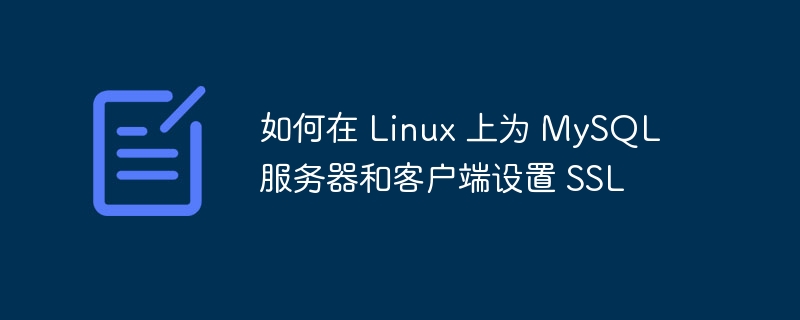집 >데이터 베이스 >MySQL 튜토리얼 >Linux에서 MySQL 서버 및 클라이언트용 SSL을 설정하는 방법
Linux에서 MySQL 서버 및 클라이언트용 SSL을 설정하는 방법
- WBOYWBOYWBOYWBOYWBOYWBOYWBOYWBOYWBOYWBOYWBOYWBOYWB앞으로
- 2023-08-26 19:05:09709검색

이 튜토리얼에서는 SSH 연결 암호화를 사용하여 MySQL 서버에 대한 보안 연결을 설정하여 데이터베이스의 데이터를 안전하게 보호하고 해커가 데이터를 훔칠 수 없도록 하는 방법을 소개합니다. SSL은 피싱 공격을 방지할 수 있는 SSL 인증서를 확인하는 데 사용됩니다. 또한 MySQL 서버에서 SSL을 활성화하는 방법도 보여줍니다.
SSL 지원 활성화
MySQL 서버에 연결하여 MySQL 서버의 SSL 상태 확인
# mysql -u root -p mysql> show variables like '%ssl%'; Output: +---------------+----------+ | Variable_name | Value | +---------------+----------+ | have_openssl | DISABLED | | have_ssl | DISABLED | | ssl_ca | | | ssl_capath | | | ssl_cert | | | ssl_cipher | | | ssl_key | | +---------------+----------+ 7 rows in set (0.00 sec) mysql> \q Bye
MySQL용 SSL 인증서 생성
인증서 파일 저장을 위한 디렉터리 생성
# mkdir /etc/certificates # cd /etc/certificates
서버 인증서 생성
# openssl genrsa 2048 > ca-key.pem Generating RSA private key, 2048 bit long modulus ...................................................................................+++ ..........+++ e is 65537 (0x10001) # openssl req -newkey rsa:2048 -days 1000 -nodes -keyout server-key.pem > server-req.pem Generating a 2048 bit RSA private key ..................+++ ..............................................................................................+++ writing new private key to 'server-key.pem' You are about to be asked to enter information that will be incorporated into your certificate request. What you are about to enter is what is called a Distinguished Name or a DN. There are quite a few fields but you can leave some blank For some fields there will be a default value, If you enter '.', the field will be left blank. ----- Country Name (2 letter code) [XX]: State or Province Name (full name) []: Locality Name (eg, city) [Default City]: Organization Name (eg, company) [Default Company Ltd]: Organizational Unit Name (eg, section) []: Common Name (eg, your name or your server's hostname) []: Email Address []: Please enter the following 'extra' attributes to be sent with your certificate request A challenge password []: An optional company name []: # openssl x509 -req -in server-req.pem -days 1000 -CA ca-cert.pem -CAkey ca-key.pem -set_serial 01 > server-cert.pem Signature ok subject=/C=XX/L=Default City/O=Default Company Ltd Error opening CA Certificate ca-cert.pem 139991633303368:error:02001002:system library:fopen:No such file or directory:bss_file.c:398:fopen('ca-cert.pem','r') 139991633303368:error:20074002:BIO routines:FILE_CTRL:system lib:bss_file.c:400: unable to load certificate Generating client certificates
# openssl req -newkey rsa:2048 -days 1000 -nodes -keyout client-key.pem > client-req.pem Generating a 2048 bit RSA private key ...............................................+++ .................+++ writing new private key to 'client-key.pem' ----- You are about to be asked to enter information that will be incorporated into your certificate request. What you are about to enter is what is called a Distinguished Name or a DN. There are quite a few fields but you can leave some blank For some fields there will be a default value, If you enter '.', the field will be left blank. ----- Country Name (2 letter code) [XX]: State or Province Name (full name) []: Locality Name (eg, city) [Default City]: Organization Name (eg, company) [Default Company Ltd]: Organizational Unit Name (eg, section) []: Common Name (eg, your name or your server's hostname) []: Email Address []: Please enter the following 'extra' attributes openssl x509 -req -in client-req.pem -days 1000 -CA ca-# cert.pem -CAkey ca-key.pem -set_serial 01 > client-cert.pem Signature ok subject=/C=XX/L=Default City/O=Default Company Ltd Error opening CA Certificate ca-cert.pem 140327140685640:error:02001002:system library:fopen:No such file or directory:bss_file.c:398:fopen('ca-cert.pem','r') 140327140685640:error:20074002:BIO routines:FILE_CTRL:system lib:bss_file.c:400: unable to load certificate to be sent with your certificate request A challenge password []: An optional company name []:
이제 my.cnf 파일을 열고 인증서 추가
# vi /etc/my.cnf [mysqld] ssl-ca=/etc/certificates/cacert.pem ssl-cert=/etc/certificates/server-cert.pem ssl-key=/etc/certificates/server-key.pem
MySQL 서버를 다시 시작하고 인증서 상태를 확인하세요
#service mysqld restart #mysql -uroot -p mysql>show variables like '%ssl%'; +---------------+-----------------------------------+ | Variable_name | Value | +---------------+-----------------------------------+ | have_openssl | YES | | have_ssl | YES | | ssl_ca |/etc/certificates/cacert.pem | | ssl_capath | | | ssl_cert | /etc/certificates/server-cert.pem | | ssl_cipher | | | ssl_key | /etc/certificates/server-key.pem | +---------------+-----------------------------------+ 7 rows in set (0.00 sec)
SSL 액세스 권한이 있는 사용자 만들기
mysql> GRANT ALL PRIVILEGES ON *.* TO ‘ssl_user’@’%’ IDENTIFIED BY ‘password’ REQUIRE SSL; mysql> FLUSH PRIVILEGES;
MySQL 클라이언트용 SSL 구성
서버 측에서 client-cert.pem 클라이언트를 변경해야 합니다. key .pem client-req.pem이 서버에서 클라이언트로 복사됩니다.
# scp /etc/ certificates/client-cert.pem root@192.168.87.158:/etc/certificates # scp /etc/ certificates/client-key.pem root@192.168.87.158:/etc/certificates # scp /etc/ certificates/client-req.pem root@192.168.87.158:/etc/certificates
파일이 클라이언트로 전송된 후 클라이언트에 연결하고 SSL 인증서를 사용하여 MySQL에 연결을 시도합니다.
# mysql --ssl-ca=ca-cert.pem --ssl-cert=client-cert.pem --ssl-key=client-key.pem -h 192.168.87.156 -u ssluser -p Welcome to the MySQL monitor. Commands end with ; or \g. Your MySQL connection id is 3 Server version: 5.1.73 Source distribution Copyright (c) 2000, 2013, Oracle and/or its affiliates. All rights reserved. Oracle is a registered trademark of Oracle Corporation and/or its affiliates. Other names may be trademarks of their respective owners. Type 'help;' or '\h' for help. Type '\c' to clear the current input statement. mysql> status -------------- mysql Ver 14.14 Distrib 5.1.73, for redhat-linux-gnu (x86_64) using readline 5.1 Connection id: 3 Current database: Current user: root@localhost SSL: Clipher in use is DHE-RSA-AES256-SHA Current pager: stdout Using outfile: '' Using delimiter: ; Server version: 5.1.73 Source distribution Protocol version: 10 Connection: 192.168.87.158 via TCP/IP Server characterset: latin1 Db characterset: latin1 Client characterset: latin1 Conn. characterset: latin1 UNIX socket: /var/lib/mysql/mysql.sock Uptime: 11 min 13 sec Threads: 1 Questions: 8 Slow queries: 0 Opens: 15 Flush tables: 1 Open tables: 8 Queries per second avg: 0.11 -------------
나중에 MySQL 서버에 영구적으로 연결할 때 SSL을 사용하여 연결하도록 /etc/my.cnf 파일에 설정을 추가하세요.
# vi /etc/my.cnf [client] ssl-ca=/etc/certificates/ client-cert.pem ssl-cert=/etc/certificates/client-cert.pem ssl-key=/etc/certificates/client-key.pem
이 구성 및 설정을 완료하면 이제 SSL 키를 사용하여 클라이언트에서 MySQL 서버에 연결하여 데이터 도난을 방지하고 해커로부터도 보호할 수 있습니다.
위 내용은 Linux에서 MySQL 서버 및 클라이언트용 SSL을 설정하는 방법의 상세 내용입니다. 자세한 내용은 PHP 중국어 웹사이트의 기타 관련 기사를 참조하세요!
성명:
이 기사는 tutorialspoint.com에서 복제됩니다. 침해가 있는 경우 admin@php.cn으로 문의하시기 바랍니다. 삭제

